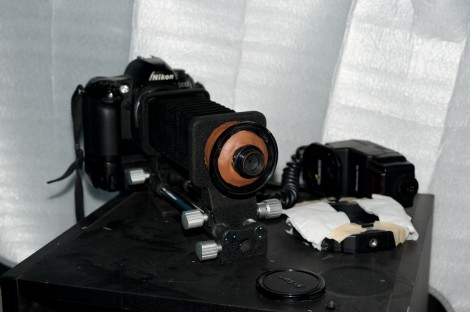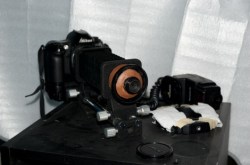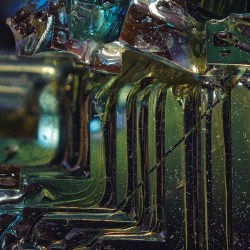
[Samuel Sargent] built his own lens for making stacked macro images.This project, which was completed as part of his senior thesis, utilizes a Zeiss enlarger lens. The aperture ring was broken, making it difficult to tell how much light was being let into the camera. Instead of scrapping the whole thing he turned it around, making it a macro lens when combined with a few other parts. He’s used a Nikon PB-5 belows, a PK-13 extension tube, and a body cap to provide a way to mount the lens to his camera. A hole was added to the body cap using his Dremel, and a liberal dose of epoxy putty seals all of the gaps.
After the break you can see a couple of photos that [Samuel] made of bismuth. He estimates the sharpest focal length by taking a few test shots. Next he captures a series of images, moving the bellows slightly between each shot. Finally, this set is combined using Helicon Focus image stacking software. Maybe for his graduate thesis he can build a mechanized platform to move the subject automatically.

















http://bigwww.epfl.ch/demo/edf/
Where’s the link to the original work?
Exactly, there are various free and open source programs that do stacking, I don’t know why hackaday actually linked to helicon unless this whole thing is an ad, they did not link to nikon after all.
Even gimp has stacking, although it’s relatively crude to do it with gimp.
Addendum: wikipedia has a nice article on it with a list of many software packages:
http://en.wikipedia.org/wiki/Focus_stacking
Seriously.
A guy hacks a camera lens and instead of props you give everyone grief,,,
unless this whole thing is an ad, they did not link to nikon after all.
You didn’t link either… here, I’ll link….
http://www.nikon.com/
Let’s try to be more supportive of our brothers from now on.!
regards, Rioexxo ®
I used Helicon after looking at many of the different pieces of software that were suggested- from the wikipedia page actually.
I found that it’s entry ease of use made it much more viable for me. I’m certainly not suggesting that everyone go out and by helicon, and I certainly would have done the work myself in photoshop had I wanted to spend hours and hours aligning each slice, but instead opted to spend about 20 minutes stacking the images with some minor tweaks to Helicon’s settings.
Workflow is very important, I simply went with what seemed the fastest and most hassle free way to stack my images. If there’s a faster more more effective way than Helicon, I’d love to learn about it. Based off my experiences with Gimp, I can safely say that’s not going to be a workable solution for me.
Is there a difference between focus stacking and z-stacking? I assume not, but you never know.. When Nasa uses this technique for the microscopic imager on the MER landers, they call it z-stacking.
@hans,
Just guessing, but perhaps it’s called Z-stacking when it’s a series of images made by using a fixed focus lens and moving the subject closer to or farther from it; and they call it focus stacking when they take a series of images while refocusing the lens instead of moving the subject.
Although after having googled a while, it looks like the words are pretty interchangeable.